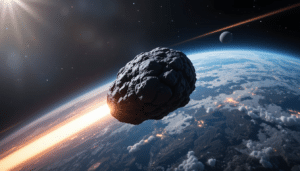
In a recent announcement, NASA Tracks 2032 Asteroid Flyby that an asteroid is set to make a close approach to Earth in 2032. While the space agency has assured the public that the likelihood of an impact is minimal, the news has sparked widespread curiosity and concern. The asteroid, designated as 2023 DW, has been closely monitored by astronomers, and its trajectory is being analyzed to determine any potential risks.
What Do We Know About Asteroid 2023 DW?
Asteroid 2023 DW is estimated to be approximately 160 feet in diameter, roughly the size of an Olympic swimming pool. It was first discovered in early 2023 and has since been tracked by NASA’s Planetary Defense Coordination Office. According to current calculations, the asteroid is expected to come within 1.2 million miles of Earth on its closest approach in 2032.
While this distance may seem vast, it’s considered a close call in astronomical terms. For context, the Moon is about 239,000 miles from Earth, making 2023 DW’s approach about five times farther than our lunar neighbor.
Is There a Risk of Impact?
NASA has emphasized that the probability of Asteroid 2023 DW hitting Earth is extremely low, with current estimates placing the odds at 1 in 560. While this might sound alarming, it’s important to note that such probabilities are common for near-Earth objects (NEOs) and rarely result in actual impacts.
However, scientists are not taking any chances. The asteroid’s orbit will be continuously monitored over the next decade to refine predictions and assess any changes in its trajectory.

How NASA Tracks Potentially Hazardous Asteroids
NASA’s Planetary Defense Coordination Office is responsible for detecting and tracking NEOs that could pose a threat to Earth. Using a network of ground-based telescopes and space observatories, the agency identifies and monitors thousands of asteroids each year.
In the case of Asteroid 2023 DW, NASA’s Sentry Impact Risk Assessment system has been employed to calculate its orbit and potential impact scenarios. This system uses advanced algorithms to predict the paths of asteroids and assess their risk levels.
What Happens If an Asteroid Threatens Earth?
While the chances of Asteroid 2023 DW hitting Earth are slim, NASA and other space agencies are prepared for such scenarios. Potential strategies to deflect or destroy an incoming asteroid include:
- Kinetic Impactors: Sending a spacecraft to collide with the asteroid and alter its trajectory.
- Gravity Tractors: Using a spacecraft’s gravitational pull to slowly change the asteroid’s path.
- Nuclear Deflection: Detonating a nuclear device near the asteroid to nudge it off course.
These methods are part of ongoing research and development efforts to protect Earth from potential asteroid impacts.
Why This Asteroid Matters
Asteroid 2023 DW serves as a reminder of the importance of planetary defense. While the likelihood of a catastrophic impact is low, the consequences could be devastating if one were to occur. Events like the Chelyabinsk meteor in 2013, which injured over 1,000 people in Russia, highlight the need for continued vigilance and investment in asteroid detection and deflection technologies.
Public Reaction and Misinformation
The announcement of Asteroid 2023 DW’s close approach has already sparked a wave of speculation and misinformation online. Social media platforms are abuzz with exaggerated claims about the asteroid’s potential to cause global destruction. NASA has urged the public to rely on verified sources and avoid sensationalized reports.
Key Takeaways:
- Asteroid 2023 DW will make a close approach to Earth in 2032, but the risk of impact is extremely low.
- NASA’s Planetary Defense Coordination Office is actively monitoring the asteroid’s trajectory.
- Planetary defense technologies are being developed to mitigate potential asteroid threats.
- Public awareness and reliance on accurate information are crucial in addressing such events.
FAQs About Asteroid 2023 DW and NASA’s Findings
1. What is Asteroid 2023 DW?
Asteroid 2023 DW is a near-Earth object (NEO) approximately 160 feet in diameter. It was discovered in early 2023 and is expected to make a close approach to Earth in 2032.
2. Will Asteroid 2023 DW hit Earth?
According to NASA, the probability of Asteroid 2023 DW hitting Earth is extremely low, with current odds estimated at 1 in 560. The asteroid is expected to pass within 1.2 million miles of Earth, which is considered a safe distance in astronomical terms.
3. How close will Asteroid 2023 DW come to Earth?
Asteroid 2023 DW is predicted to come within 1.2 million miles of Earth during its closest approach in 2032. For comparison, the Moon is about 239,000 miles away from Earth.
4. What is NASA doing about Asteroid 2023 DW?
NASA’s Planetary Defense Coordination Office is actively tracking Asteroid 2023 DW using ground-based telescopes and space observatories. The agency’s Sentry Impact Risk Assessment system is continuously analyzing the asteroid’s trajectory to refine predictions and assess any potential risks.
5. What happens if an asteroid threatens Earth?
NASA and other space agencies have developed several strategies to mitigate asteroid threats, including:
- Kinetic Impactors: Colliding a spacecraft with the asteroid to alter its path.
- Gravity Tractors: Using a spacecraft’s gravitational pull to slowly change the asteroid’s trajectory.
- Nuclear Deflection: Detonating a nuclear device near the asteroid to nudge it off course.
6. How often do asteroids come close to Earth?
Asteroids pass near Earth regularly, with thousands of near-Earth objects (NEOs) being tracked by NASA. Most of these asteroids are small and pose no threat, but larger ones like 2023 DW are closely monitored.
7. What was the Chelyabinsk meteor event?
The Chelyabinsk meteor was a 65-foot-wide asteroid that entered Earth’s atmosphere over Russia in 2013. It exploded in the air, releasing a shockwave that injured over 1,000 people and caused widespread damage. This event highlights the importance of asteroid detection and planetary defense.
8. Should I be worried about Asteroid 2023 DW?
No, there is no need for immediate concern. NASA has confirmed that the risk of impact is very low, and the asteroid will likely pass safely by Earth. However, NASA will continue to monitor its trajectory to ensure accurate predictions.
9. How can I stay updated on Asteroid 2023 DW?
For the latest updates, visit NASA’s official website or follow the Planetary Defense Coordination Office. Avoid relying on sensationalized or unverified sources.
10. Why is tracking asteroids important?
Tracking asteroids is crucial for planetary defense. While the likelihood of a catastrophic impact is low, the consequences could be devastating. Monitoring near-Earth objects helps scientists develop strategies to protect Earth from potential threats.
Disclaimer: The information provided in this article is based on publicly available data from NASA and other reputable sources. While every effort has been made to ensure accuracy, details about Asteroid 2023 DW and its trajectory may change as new data becomes available. This article is for informational purposes only and does not constitute professional advice or a definitive prediction of future events. Always rely on official sources like NASA for the latest updates on near-Earth objects and planetary defense.